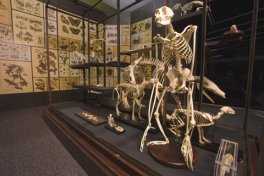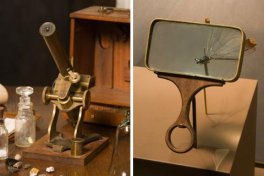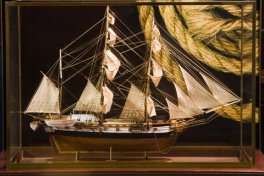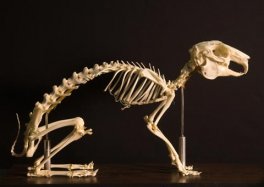
About the exhibition
Darwin reveals the experiences that first led Charles Darwin to formulate his groundbreaking theories. The exhibition explores the life and work of the man whose theory of evolution forever changed the perception of the origin and nature of species on Earth. It celebrates 200 years since the birth of this great naturalist, geologist and thinker. Through artefacts, documents, film, computer interactives, live animals and plants, as well as Darwin's own personal items, this landmark international exhibition provides a fascinating insight into the man almost 150 years after the publication of his revolutionary work, On the Origin of Species.
Skeleton from the 'World Before Darwin' section of the exhibition.
Photo: Jason McCarthy.
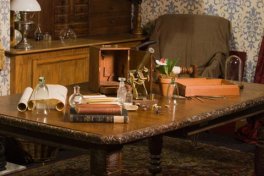 Exhibition highlights
Exhibition highlights
- original notebooks used by Darwin on his voyage on the HMS Beagle
- an elaborate reconstruction of Darwin's study
- live animals, such as an iguana and blotched blue tongue lizard
- a vibrant and colourful montage of live orchids, and
- the connections between Darwin and Australia, both during and after his visit in 1836.
An elaborate reproduction of the table in Charles Darwin's study at Down House. Photo: Jason McCarthy.
Exhibition sections
The exhibition is divided into eight sections, covering themes across Darwin's life and work:
Introduction
The introduction to the Darwin exhibition is a comprehensive examination of Darwin's life and seminal discoveries as well as the science of evolution and natural selection.
This section looks at how Darwin's predecessors saw the natural world as static and immutable, and had no real understanding of the mechanisms by which species could adapt or change over time. It provides an introduction to the exhibition by exploring attitudes to the natural world before Darwin. An antique display case filled with mammal, reptile and bird skeletons evokes the scientific landscape of the early 19th century.
Skeleton case from the 'World Before Darwin' section of the exhibition.
Photo: Jason McCarthy.
Young Naturalist
Darwin's family heritage and early life through letters, photographs and personal items is explored in this section. Darwin's passionate pursuit of naturalism and geology secured him a berth on HMS Beagle. The Life and Work of Charles Darwin, a video biography of Darwin, narrated by his great-great-grandson Randal Keynes, introduces visitors to the political, social, and scientific climates of 19th century England.
Left: Microscope, similar to that used by Charles Darwin. Collection of the American Museum of Natural History, New York. Right: Magnifying glass, 1800s, similar to that used by Charles Darwin. Photos: Jason McCarthy.

